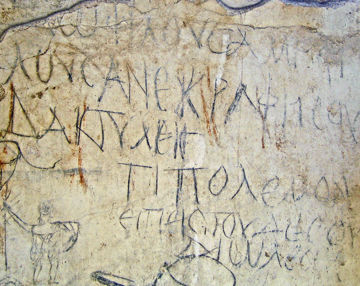Declaration of Love and Literary Allusion
[φι]λ̣ῶ φιλοῦσα μὴ φι =
λοῦσαν. ἐκράφη σου
δακτυλε̣ι̣ς̣.
<:vacat> τί πόλεμον
<:vacat> εἴπεις; τοῦ δὲ σοῦ
<:vacat> διώλεσεν̣;
| Translation: | “I love, loving one who does not love (me). It was written with your fingers (?). What war do you mean? Who killed these?” |
|---|---|
| Findspot: |
Smyrna, Basilica
(Agora.1)
|
| Language: | Greek |
| Writing Style: | charcoal |
|
|
| Apparatus Criticus: | 1–2. The feminine in the participle φιλοῦσα suggests a female writer (or at least persona), the only demonstrable such case among the graffiti. There is, however, a likely case of female homoerotic desire expressed in Pompeian graffiti, now discussed at length by Milnor, K., Graffiti and the Literary Landscape in Roman Pompeii (2014): 191–223. The Pompeian texts raise complex issues, fully treated by Milnor, about agency and authorship; some of those face us as well in the present graffito, but its more pedestrian and (in the first part) non-literary character may make us more inclined to see in it actual selfexpression by a woman than some would wish to admit in the Pompeian case. 2. ἐκράφη, κ corrected from χ. Read ἐγράφη. The αν preceding is written in somewhat larger letters than what precedes, which might lead one to consider ἀνεκράφη. But we cannot see how to make acceptable Greek of μὴ φίλους, so both grammar and sense seem to support the reading printed. That, of course, points to a female object of the love of the female writer/ persona in line 1. It is not clear to us if the following three words are the product of the same writer or of a second writer responding in some fashion (cf. note to line 3). The letters seem much the same. 3. Between lambda and sigma the writer’s final intentions are not clear. It appears that (s)he first wrote an eta, then changed that to epsilon-iota. As there is no form δακτυλεις in Greek, it seems most likely that the writer intended δακτύλοις; one might perhaps translate “It was written with your fingers.” But the significance of this is unclear to us. 4–6. These lines, written as noted in a smaller and somewhat cruder hand, are indented as shown. Whether that is the case because the figure drawn to their left was already in place, we cannot say. They offer a remarkably garbled reminiscence of, or attempt to quote, Euripides, Herc. 1134, τί πόλεμον εἶπας; τούσδε τίς διώλεσεν; Herakles has just recovered from madness and found his children dead. For Euripides on the wall at Pompeii, cf. Milnor, K., Graffiti and the Literary Landscape in Roman Pompeii (2014): 233. The concluding nu in line 6 is uncertain and could be a sigma; that would only increase the garbling of the quotation. |
| Bibliography: | Bagnall, R. S. et al., Graffiti from the Basilica in the Agora of Smyrna (2016): 290-292. Bagnall, R., Everyday Writing in the Graeco-Roman East (2011): 15-16. SEG 61.958. |
| Suggested Citation: | AGP-SMYT00291, The Ancient Graffiti Project, <http://ancientgraffiti.org/Graffiti/graffito/AGP-SMYT00291> [accessed: 10 May 2024] |
| Contributions: |
Editor: Roger S. Bagnall Principal Contributor: Roger S. Bagnall Last Revision: 2016-10-03 |
